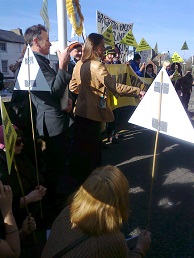Section 14
 March 28th Friday, grey skies, but it's not raining yet and not so chilly as yesterday. What a busy week! Zooming down to the Law Courts and back, coaxing the Ann Halam ghost stories series through the Smashwords process (more haste less speed, most of them go straight through but then always that little niggle in the formatting to be tracked down, in the oldest text and the one I processed at the end of a long day).
March 28th Friday, grey skies, but it's not raining yet and not so chilly as yesterday. What a busy week! Zooming down to the Law Courts and back, coaxing the Ann Halam ghost stories series through the Smashwords process (more haste less speed, most of them go straight through but then always that little niggle in the formatting to be tracked down, in the oldest text and the one I processed at the end of a long day). Cold weather, frost on the grass, planting celandines in the green under the newly pruned elm, taking delivery of the swan mussels that are going to solve the algae problems without chemical aid; and of three more very charming little sticklebacks, blue-silver lances, miniscule barracuda (disappeared instantly, moment they were transfered from their holding tank).
A great leap forward on Tuesday evening, the first consolidated anti-fracking meeting in Brighton; lots of interesting stuff, and a relief to the nagging irritation of seeing all those disparate petitions, collecting tens of thousands of signatories each. Doomed we may be, and I fear we are, but that's no excuse for untidiness. And the DECC consultation on the next round of fracking licences (you missed that, dear readers. You were meant to, even if you did have something to say about the prospect of 33,000 dirty energy fracking wells in Lancashire, 2,800 in the Low Weald . . . (the coming round puts 60% of the land area of the UK up for tender. Wherever you are, you'll have your own little piece of Pensylvania's misery, don't worry). The environmental assessment consultation document, prepared by some engineering suppliers outfit called Amec, bore an amazingly close resemblance to the "EA" documents presented by the fracking companies themselves (trust me, I know), and found no adverse effects at all, none to speak of. Now there's a surprise.
And back to court, where yesterday we considered that debatable Section 14 order, signed off by the Deputy Chief Constable on 16th August, suddenly served by the police on sundry Balcombe protectors, 19th August 2013. Is a Section 14 (Public Order Act, 1986) a kind of lettre de cachet of public assembly, where the name of any assembly or other can be entered on the dotted line, that a senior officer can sign off at his leisure and the police can apply whenever they choose, arbitrarily? Or is the order required to be case specific, issued at the scene by a senior officer actually present, who has assessed a specific public assembly as violent and dangerous . . ? I tend to take the former view, but then I would, wouldn't I? One of the violent, dangerous defendants (accused of sitting down outside the gates of a drilling site vacant except for two persons that day, and having a back entrance if emergency exit was needed) is my MP. The other four don't look very threatening either, although I can't speak for their having hairy armpits or not. The Public Proescutor favours the latter, but then he would, wouldn't he. Our judge appeared to feel it was a pretty point of law, and though he's looking really tired of all this, he allowed our learned friends to mull it over with him for two mortal hours yesterday afternoon.
It's fascinating, it's totally Dickensian, I'm gripped, as if by quicksand. Must get back there now.

Comments
Display comments as Linear | Threaded